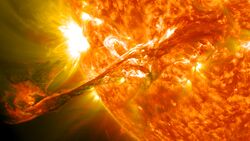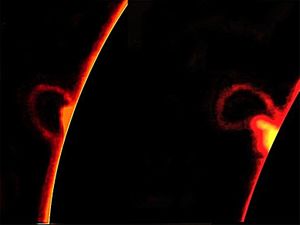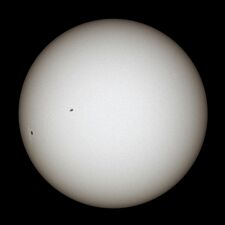اندلاع شمسي
| الفيزياء الشمسية |
|---|
| الظواهر |
الاندلاع أو التوهج Flare هو وهج ساطع أي انفجار يندفع من الغلاف اللوني الشمسي بشكل مفاجئ لا تتجاوز مدته دقائق معدودة ما يلبث أن ينطفئ بعد نحو ساعة من الزمان، مطلقاً ما يزيد عن 6 × 1025 جول من الطاقة.[1] التعبير يستخدم أيضاً ليشير لظاهرة مماثلة في النجوم الأخرى، حيث يستخدم التعبير الملائم وهو وهج نجمي.
Although originally observed in the visible electromagnetic spectrum, especially in the Hα emission line of hydrogen, they can now be detected from radio waves to gamma-rays.
Flares are closely associated with the ejection of plasmas and particles through the Sun's corona into outer space; flares also copiously emit radio waves. If the ejection is in the direction of the Earth, particles associated with this disturbance can penetrate into the upper atmosphere (the ionosphere) and cause bright auroras, and may even disrupt long range radio communication. It usually takes days for the solar plasma ejecta to reach Earth.[2] Flares also occur on other stars, where the term stellar flare applies. High-energy particles, which may be relativistic, can arrive almost simultaneously with the electromagnetic radiations.
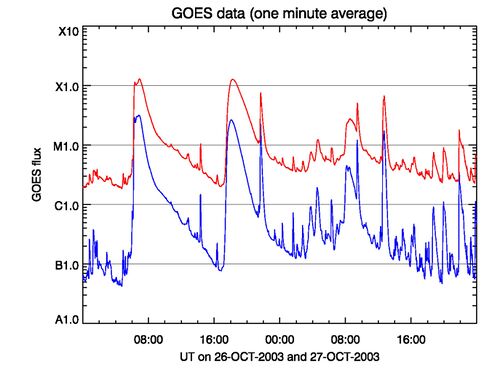
. . . . . . . . . . . . . . . . . . . . . . . . . . . . . . . . . . . . . . . . . . . . . . . . . . . . . . . . . . . . . . . . . . . . . . . . . . . . . . . . . . . . . . . . . . . . . . . . . . . . . . . . . . . . . . . . . . . . . . . . . . . . . . . . . . . . . . . . . . . . . . . . . . . . . . . . . . . . . . . . . . . . . . . .
التصنيف
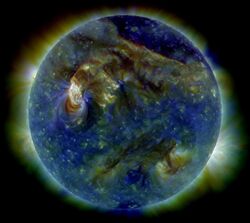
The classification system for solar flares uses the letters A, B, C, M or X, according to the peak flux in watts per square metre (W/m2) of X-rays with wavelengths 100 to 800 picometres (1 to 8 ångströms), as measured at the Earth by the GOES spacecraft.
| Classification | Approximate peak flux range at 100–800 picometre (watts/square metre) |
|---|---|
| A | < 10−7 |
| B | 10−7 – 10−6 |
| C | 10−6 – 10−5 |
| M | 10−5 – 10−4 |
| X | > 10−4 |
The strength of an event within a class is noted by a numerical suffix ranging from 0 to 9, which is also the factor for that event within the class. Hence, an X2 flare is twice the strength of an X1 flare, an X3 flare is three times as powerful as an X1, and only 50% more powerful than an X2.[4] An X2 is four times more powerful than an M5 flare.[5]
تصنيف H-alpha
An earlier flare classification was based on Hα spectral observations. The scheme uses both the intensity and emitting surface. The classification in intensity is qualitative, referring to the flares as: faint (f), normal (n) or brilliant (b). The emitting surface is measured in terms of millionths of the hemisphere and is described below. (The total hemisphere area AH = 15.5 × 1012 km2.)
| التصنيف | المساحة المصحـَحة (واحد على مليون من نصف الكرة) |
|---|---|
| S | < 100 |
| 1 | 100–250 |
| 2 | 250–600 |
| 3 | 600–1200 |
| 4 | > 1200 |
A flare then is classified taking S or a number that represents its size and a letter that represents its peak intensity, v.g.: Sn is a normal sunflare.[6]
المخاطر
الأرصاد
Flares produce radiation across the electromagnetic spectrum, although with different intensity. They are not very intense in visible light, but they can be very bright at particular atomic lines. They normally produce bremsstrahlung in X-rays and synchrotron radiation in radio.
التاريخ
الأرصاد البصرية
Richard Carrington observed a flare for the first time on 1 September 1859 projecting the image produced by an optical telescope through a broad-band filter. It was an extraordinarily intense white light flare. Since flares produce copious amounts of radiation at Hα, adding a narrow ( ≈1 Å) passband filter centered at this wavelength to the optical telescope allows the observation of not very bright flares with small telescopes. For years Hα was the main, if not the only, source of information about solar flares. Other passband filters are also used.
الأرصاد الراديوية
During World War II, on February 25 and 26, 1942, British radar operators observed radiation that Stanley Hey interpreted as solar emission. Their discovery did not go public until the end of the conflict. The same year Southworth also observed the Sun in radio, but as with Hey, his observations were only known after 1945. In 1943 Grote Reber was the first to report radioastronomical observations of the Sun at 160 MHz. The fast development of radioastronomy revealed new peculiarities of the solar activity like storms and bursts related to the flares. Today ground-based radiotelescopes observe the Sun from c. 15 MHz up to 400 GHz.
تلسكوپات الفضاء
Since the beginning of space exploration, telescopes have been sent to space, where they work at wavelengths shorter than UV, which are completely absorbed by the atmosphere, and where flares may be very bright. Since the 1970s, the GOES series of satellites observe the Sun in soft X-rays, and their observations became the standard measure of flares, diminishing the importance of the Hα classification. Hard X-rays were observed by many different instruments, the most important today being the Reuven Ramaty High Energy Solar Spectroscopic Imager (RHESSI). Nonetheless, UV observations are today the stars of solar imaging with their incredible fine details that reveal the complexity of the solar corona. Spacecraft may also bring radio detectors at extremely long wavelengths (as long as a few kilometers) that cannot propagate through the ionosphere.
التلسكوپات البصرية
- Big Bear Solar Observatory, located in Big Bear Lake, California and operated by the New Jersey Institute of Technology, is a solar dedicated observatory with different instruments, as well as a huge data bank of full disk Hα images.[7]
- Swedish 1-m Solar Telescope, operated by the Institute for Solar Physics (Sweden), is located in the Observatorio del Roque de los Muchachos on the island of La Palma (Spain).
- McMath-Pierce Solar Telescope, located at Kitt Peak National Observatory in Arizona, is the world's largest solar telescope.
التلسكوپات الراديوية
- Nançay Radioheliographe (NRH) is an interferometer composed of 48 antennas observing at meter-decimeter wavelengths. The radioheliographe is installed at the Nançay Radio Observatory, France.[8]
. . . . . . . . . . . . . . . . . . . . . . . . . . . . . . . . . . . . . . . . . . . . . . . . . . . . . . . . . . . . . . . . . . . . . . . . . . . . . . . . . . . . . . . . . . . . . . . . . . . . . . . . . . . . . . . . . . . . . . . . . . . . . . . . . . . . . . . . . . . . . . . . . . . . . . . . . . . . . . . . . . . . . . . .
تلسكوپات الفضاء
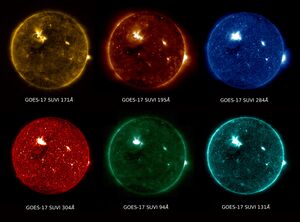
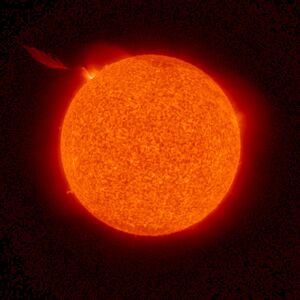
أمثلة للتوهجات الشمسية الكبيرة
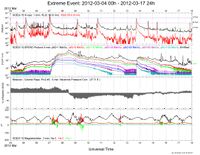
رذاذ الوهج
Flare sprays are a type of eruption associated with solar flares.[10] They involve faster ejections of material than eruptive prominences,[11] and reach velocities of 20 to 2000 kilometers per second.[12]
التوقع
Current methods of flare prediction are problematic, and there is no certain indication that an active region on the Sun will produce a flare. However, many properties of sunspots and active regions correlate with flaring. For example, magnetically complex regions (based on line-of-sight magnetic field) called delta spots produce the largest flares. A simple scheme of sunspot classification due to McIntosh, or related to fractal complexity[13] is commonly used as a starting point for flare prediction.[14] Predictions are usually stated in terms of probabilities for occurrence of flares above M or X GOES class within 24 or 48 hours. The U.S. National Oceanic and Atmospheric Administration (NOAA) issues forecasts of this kind.[15] MAG4 was developed at the University of Alabama in Huntsville with support from the Space Radiation Analysis Group at Johnson Space Flight Center (NASA/SRAG) for forecasting M and X class flares, CMEs, fast CME, and Solar Energetic Particle events.[16]
. . . . . . . . . . . . . . . . . . . . . . . . . . . . . . . . . . . . . . . . . . . . . . . . . . . . . . . . . . . . . . . . . . . . . . . . . . . . . . . . . . . . . . . . . . . . . . . . . . . . . . . . . . . . . . . . . . . . . . . . . . . . . . . . . . . . . . . . . . . . . . . . . . . . . . . . . . . . . . . . . . . . . . . .
انظر أيضا
- الغلاف اللوني
- بقعة شمسية
- الشمس
- Coronal mass ejection
- نجم اندلاعي
- Geomagnetic storm
- Aurora (astronomy)
- Magnetic reconnection
المصادر
- مؤمن, عبد الأمير (2006). قاموس دار العلم الفلكي. بيروت، لبنان: دار العلم للملايين.
{{cite book}}: Cite has empty unknown parameter:|طبعة أولى coauthors=(help)
|
- "Superflares could kill unprotected astronauts". NewScientist.com. Retrieved 17 June 2005.
{{cite web}}: Unknown parameter|dateformat=ignored (help) - Mewaldt, R.A., et al. 2005. Space weather implications of the 20 January 20, 2005 solar energetic particle event. Joint meeting of the American Geophysical Union and the Solar Physics Division of the American Astronomical Society. May 23-27. New Orleans. Abstract.
- Solar Flares NASA Video from 2003
- Solar Flares Solar & Heliospheric Observatory Video from 2002
وصلات خارجية
- Solar Cycle 24 and VHF Aurora Website (www.solarcycle24.com)
- Solar Weather Site
- STEREO Spacecraft Site
- Early BBC report on the November 4, 2003 flare
- Later BBC report on the November 4, 2003 flare
- NASA SOHO observations of flares
- Stellar Flares - D. Montes, UCM.
- The Sun - D. Montes, UCM.
- ASC / Alliances Center for Astrophysical Thermonuclear Flashes
- 'The Sun Kings', lecture by Dr Stuart Clark on the discovery of solar flares given at Gresham College, 12 September 2007 (available as a video or audio download as well as a text file).
- An X Class Flare Region on the Sun - NASA Astronomy Picture of the Day
- Sun trek website An educational resource for teachers and students about the Sun and its effect on the Earth
- NASA - Carrington Super Flare NASA May 6, 2008
- Archive of the most severe solar storms

